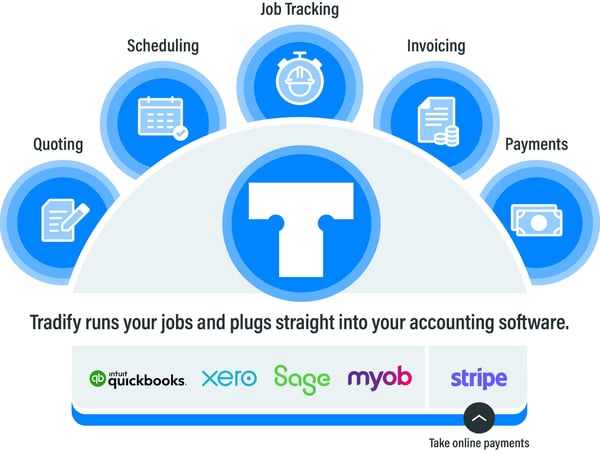Cash Flow Forecasting for Trades + Free Calculator!
by Team Tradify, March 19, 2023

Table of Contents
The importance of forecasting cash flow
Cash flow is a critical component of small business success. This is especially true if you run a trade business. Your ability to purchase tools and supplies, pay staff, and keep your vehicles running, relies on having cash in the bank.

At Tradify we see cash flow issues reflected in customer data around the number of jobs completed compared to the number of invoices marked as paid. For small businesses, cash flow is really important as often there is a minimal amount of capital available for the owner/s to fall back on if times get tough. To make things easier, we've created a Cash Flow Forecast Template that you can download and fill out yourself.
We discussed the importance of cash flow with accountant Bryn Harwood on our 'Behind the Tools' podcast. Bryn goes into detail about how he helps his clients manage their cash flow. He also explains how cash flow issues can prevent you from:
- Paying staff
- Providing certain services
- Ordering materials
- Committing to future work
- Investing in R&D or marketing
Jump ahead:
- 1. What is the difference between cash flow and profit?
- 2. Cash flow trends in the trade and construction industry
- 3. The cash flow challenge
- 4. How to improve your cash flow
- 5. Forecasting your cash flow
- 6. Seven simple steps to using the cash flow forecast template
- 7. Develop an action plan based on your cash flow forecast
- 8. How to increase profitability in your trade business
- 9. Understanding costs
- 10. Creating a plan for profitability
1. What is the difference between cash flow and profit?
Cash flow is the measure of all cash that comes in and goes out of a business. Profit (also called revenue) is the amount of money left in a business after all expenses have been paid. Both numbers are important to the health and success of a business, but it depends on your individual business goals.
In general, cash flow is more important for the day-to-day running of a business. Good cash flow means you can continue to pay your bills. Profit, on the other hand, is a broader measure of success. If your annual profit continues to increase every year, it's a good sign you're running a successful business.
If more money is coming into your business than going out, you have positive cash flow — enough to pay all your bills. If your cash flow is negative, you’ll eventually become overdrawn and will need to source extra money to cover the difference.

2. Cash flow trends in the trade and construction industry
Xero Small Business Insights analysed data from tens of thousands of small businesses, and have noted interesting trends both in the trade and construction industry, and the wider small business sector. Throughout the year, cash flow and profitability fluctuate seasonally. In the construction industry, in particular, there are some interesting trends. One of these is a large dip in cash flow during January, which takes until March to recover.
This January dip is interesting because it coincides with a significant spike in December – consistently the best month of the year for construction companies getting paid.
Why are tradespeople getting paid so much in December, but struggling during January?
On the surface, this probably relates to the Christmas/New Year shutdown and holiday period. In a labour-led industry, if you’re not working — you’re not being paid. Because many tradespeople take their own holidays in December/January, and all their clients are also on holiday, the work dries up post-Christmas. The December glut can be accounted for by clients who want their work done before the Christmas holiday, and they’re willing to pay for the privilege, especially as the boom in the industry stretches resources.
3. The cash flow challenge
Keeping track of your cash flow and learning how to predict it is essential for tradies, always. Even in good times, it can be tough to strike a balance between customers paying their invoices and supplier bills. It’s even more important to have a clear picture of your cash flow in tougher times.
Cash flow is like a picture of your business bank account over time. If your cash flow is positive, you have more money coming in than going out, and you have enough money to pay all of your bills, your team and yourself. If the opposite is true - you have more money going out than coming in - your bank account will eventually become overdrawn and you will need to source extra money to cover the difference.
As a trade business, It’s always important for you to have a good understanding of exactly how much money you have coming in and how much money you have going out of your business. It’s even more important in tough times when you’re facing a decline in income, even if (hopefully) it’s only for a short time.
4. How to improve your cash flow
Getting paid on time is a huge hurdle across all trade businesses. More tradespeople are utilising features such as payment reminders and accepting deposits upfront to help mitigate the damage late payments cause to cash flow. Some tradespeople are also integrating Stripe and Paypal payments into invoices. Xero points out that invoices paid via Stripe or Paypal (in conjunction with Xero) are paid 10 days faster than other invoices.
Things are looking up for tradespeople worried about cash flow, but the key to managing your profitability is the ability to measure it. Small businesses like tradespeople are always susceptible to market changes and seasonal shifts, which can wreak havoc on cash flow if you’re not prepared. Cloud-based software like Tradify enables you to gain visibility over your cash flow so you can effectively manage your business.
Tradify also talks to your favourite accounting software:
Two quick tips to improve cash flow
Slow and late paying clients are one of the biggest headaches for tradespeople, because delayed payments have a direct impact on your cash flow. Here are two ways to get clients to pay you faster:
1. Invoice quickly. Don’t wait too long after the work has been completed before you issue your clients invoices and make sure you send your invoices by email, not by snail mail. For larger jobs, it’s common to request an upfront deposit and you can also consider using progress payments to get cash in sooner for larger or longer jobs.
2. Make it easy for your clients to pay you. Clients are more likely to pay sooner if you make it easier for them. Make sure your invoices are clear, easy to understand and easy to pay. Provide payment options on the invoice such as click to pay via credit card or direct deposit. Reducing the length of time it takes your clients to pay your invoices can quickly boost your cash flow.
5. Forecasting your cash flow
The first step towards understanding and improving your cash flow is learning how to forecast it. To begin, you need to understand your current cash flow situation. We know. It’s probably not going to look pretty at the moment. But you’ve got to know how you’re situated before you can work out how to put a plan in place to improve it.
To make things easier, we've created a Cash Flow Forecast Template that you can download and fill out yourself.
Our Cash Flow Forecast Template will help you:
- Understand your cash flow - get a clear picture of the cash coming in and going out of your business and predict what this will look like in future.
- Crunch the numbers - the cash flow forecast template will automatically calculate your cash flow on a month to month (and total) basis for the forecast period.
- Answer 'what if' questions - A cash flow forecast does much more than help you make predictions. Use it to estimate the impact of increased costs, decreased income, and as a base for financial decisions. For example, you can figure out what would happen if your income decreased by x% for 3 months.
- Improve cash flow - With a clear view of your expenses and income, you’ll be able to identify opportunities to reduce or delay expenses and assess the impact of these changes.
An accurate cash flow forecast will help you make decisions for the future. If you know when your business will hit a slow patch, you’ll be able to plan ahead for it. Likewise, by knowing when you’ll have a period of strong cash flow, you might decide to expand or hire staff.
Predict 12 months of cash flow
The aim of the cash flow forecast template is to help you predict your cash flow on a month-to-month basis, or for the whole year. It might look a bit intimidating at first, so this guide is designed to help you get familiar with it.
Try to be as accurate as possible with your figures. It’s worth putting some time and thought into getting these figures right as this forecast is what you’ll show your bank or other lenders.
An example:
If you estimate your cash flow for a month to be $/£ 50,000, consider how feasible this number really is. There are only so many hours in the day and you’ll only be able to complete a certain number of jobs with a certain number of customers.
Remember that even if you invoice $/£ 50,000 of sales in a month, you can’t guarantee the full amount will be paid on time. According to Xero, around 50% of small business invoices are paid late.
For your cash flow forecast it may make sense to estimate something like:
- 80% of invoices are paid in the month of billing.
- 10% are paid a month later.
- 10% are paid two months later.
What does the cash flow forecast template do?
The cash flow forecast template records the cash ‘flowing’ in and out of your business. All the figures you use should include GST.
Enter the following information into the template:
- Receipts — your sales and any other cash that might come in, for each month you’re forecasting.
- Direct costs — these are materials, stock, equipment etc.
- Overheads — these are your monthly expenses, like wages, rent, power and phone.
- Opening bank balance — how much cash you have to start with.
When you’ve done this, the template will automatically calculate the following on a month-to-month and total basis for the forecast period:
- Total receipts — incoming cash.
- Total cash payments — outgoing cash.
- Net cash flow — the difference between cash coming in and going out over a fixed period of time.
- Closing bank balance — how much cash you have at the end of the month
6. Seven simple steps to using the cash flow forecast template
Our Cash Flow Forecast Template is built in Excel.
- Step 1: Enter your business name at the top. (Cell C16)
- Step 2: Select a starting month from the dropdown list (cell C19)
- Step 3: Enter your sales and other cash receipts figures for each month you’re forecasting. Remember, you probably won’t get all of your invoices paid in the same month.
- Step 4: Enter your direct costs and overheads for each month you’re forecasting.
- Step 5: Enter your opening bank balance (Cell D56)
- Step 6: Use the calculations to analyse your cash flow.
- Step 7: Print your completed cash flow forecast, and use it to keep track of your cash flow.
Quick tip: If you don’t have detailed forecast numbers for some of these categories for the next few months, use last month’s actuals as a starting point. Then update as you get more accurate information based on jobs scheduled.
7. Develop an action plan based on your cash flow forecast
Once you have a clear view of your current cash flow and your cash flow forecast for the next few months, then you can take action. Here are a few things to think about as you consider how you might be able to positively impact the cash flow in your trade business.
- Reducing expenses: Take a close look at your expenses - both your variable expenses and your overhead costs. Review every single expense and overhead cost. Are there any expenses you can reduce, even if only for a short period of time? If you reach out to suppliers, you’ll find that many might be prepared to cut you some slack, if they can.
- Increasing rates: Can you increase your rates? If you’re delivering a premium service, are you charging appropriately?
- Issue all invoices: Have you invoiced for all of the work you completed? If not, get those invoices out now. Remember, the more quickly you send an invoice, the better the chances of it getting paid.
- Customers: can you reach out to customers now to get a commitment to do rescheduled jobs as soon as you are legally and safely able to do so? At a minimum, do what you can to stay in touch with your customers - let them know you’re taking a short break but you’ll be ready to serve them again soon.
- Invoicing: As soon as things pick up, think about using progress invoicing where you invoice for part of the job upfront, or mid-way through - don’t wait till you’ve finished the job until you invoice anything at all. This can make a big difference to your cash flow - especially for big jobs.
- Marketing: Been meaning to get your website or Facebook page sorted? Do it now!
- Customer reviews: Haven’t asked for customer reviews? Do it now - while you have some time.
- Business improvements: Use job management software like Tradify to streamline your business admin.
8. How to increase profitability in your trade business
To get serious about growing your business you first need to understand how it’s performing. The cash flow forecast will help with that. Once you know how you are doing, you can devise a plan to do better. Increasing profitability starts with reducing costs.
The three-step process is as follows:
- Understand your costs
- Devise a plan (that includes cost reduction)
- Execute plan (starting with cost reduction)
9. Understanding costs
If you’ve been using accounting software and a job management system like Tradify then this should be pretty easy. Otherwise, sit down with your bookkeeper or accountant. Any costs involved in completing this work will be recovered in savings, so don't let that be an excuse. This process is most likely going to show you that your key costs are related to suppliers, labour and overheads.
Supplier costs
For most contractors, your ability to get a market-leading rate from key suppliers may be limited. The best way to look at supplier costs is to consider both the inputs and outputs.
For inputs, you should compare supplier costs across a small selection of suppliers at least once a year. To do this effectively all you need to do is to create a small 'basket' of key items and check with a selection of suppliers as to what this basket of goods would cost given a likely order volume (based on the last three months work). This will pretty quickly tell you whether or not you're getting the best rate available to you.
For outputs, you just need to check your margins or markups. Make sure you are applying an appropriate markup to any and all materials used on a job. You also need to be sure you're accurately tracking all your time and materials via a job management system so you can recover those costs. The easiest approach to markups is just to be super transparent and let all your customers know that you charge 10%-15% markup on all materials to cover credit, delivery, and warranty costs.
Labour costs
To lower labour costs you either lower your wage bill or you get more productive. The best place to start is labour productivity. You need to start comparing productivity and profitability by employee. Look at who is completing the most chargeable hours by job level and review the margin per chargeable hour. This will quickly show you who is generating the most value and who is costing you. You can then take action based on the results.
The next place to look is productivity. Are you doing everything you can to ensure everyone can be as productive as possible? Are you ordering materials online in advance to save time? Are you scheduling and allocating jobs well ahead of time to avoid further downtime or errors on the job? Do you have productivity tools in place such as a job tracking system or tablets in each van?
Overheads
Overheads are often the biggest opportunity percentage wise as it dramatically increases as sales drop. The obvious place to start with overheads is recurring costs. A tool like Xero makes it super easy to quickly spot these items.
The easiest ones to tackle are your insurance, phone, internet and mobile costs. It takes nothing more than a quick call to the competition to find out if you're getting a good deal. When it comes to insurance, make sure you are adequately covered and don't just take the lowest rate. Before you make any decisions, ensure there aren't any hidden costs such as setup, installation, or contract break fees.
Once you’ve reviewed those items just move down the list focusing on the biggest recurring overheads.
Another quick way to manage overheads down is to focus on ruthlessly managing and tracking your activities and making every job count. Paying close attention to non-chargeable activities and expenses will quickly help stop you losing money.

10. Creating a plan for profitability
Like most business owners you probably spend most of your time just making the wheels turn, booking jobs, finishing the job, invoicing customers and paying bills. Given this, don't bother with a 20-page work of art, just complete our Business Plan Template. It's not just for those starting out — even established businesses can benefit from putting a plan in place.

The plan (whether you use our template or not) will force you to look at some of the key metrics in your business so you can start to make interventions designed to improve your performance. To complete the plan you’ll need to know your cash flow, profit and loss, and sales performance for the last quarter. Sales performance includes things like the number of leads you dealt with, the number of quotes you won and lost and the number of existing customers you contacted.
Executing your profitability plan
A plan is no good if you do nothing with it so now it's time to start executing the plan. By now you will have identified a number of cost items and sales activities that need closer attention over the following months.
Once you’ve completed your business plan it's time to keep it somewhere you will see it often. Even better, share it with the team, your mentors or advisors, or even your family to make sure someone holds you to account. Putting your plan out in the wild will keep it front of mind as you focus your efforts on increasing profits.
Ready to give Tradify a go?
A job management system like Tradify is an easy way to streamline your trade business admin. Start your 14-day free trial today or sign up for one of our weekly product walkthroughs to see if Tradify is right for your business.
Related articles

How To Keep Your Trade Business Running When You’re on Holiday

Digital Marketing for Small Businesses + Free Marketing Plan

5 Great Gift Ideas For Tradies
Give Tradify a go for free!
Save 10+ hours/week on business admin with the highest-rated job management software for tradespeople.
With free one-on-one training and phone support, it's never been easier to get started.



